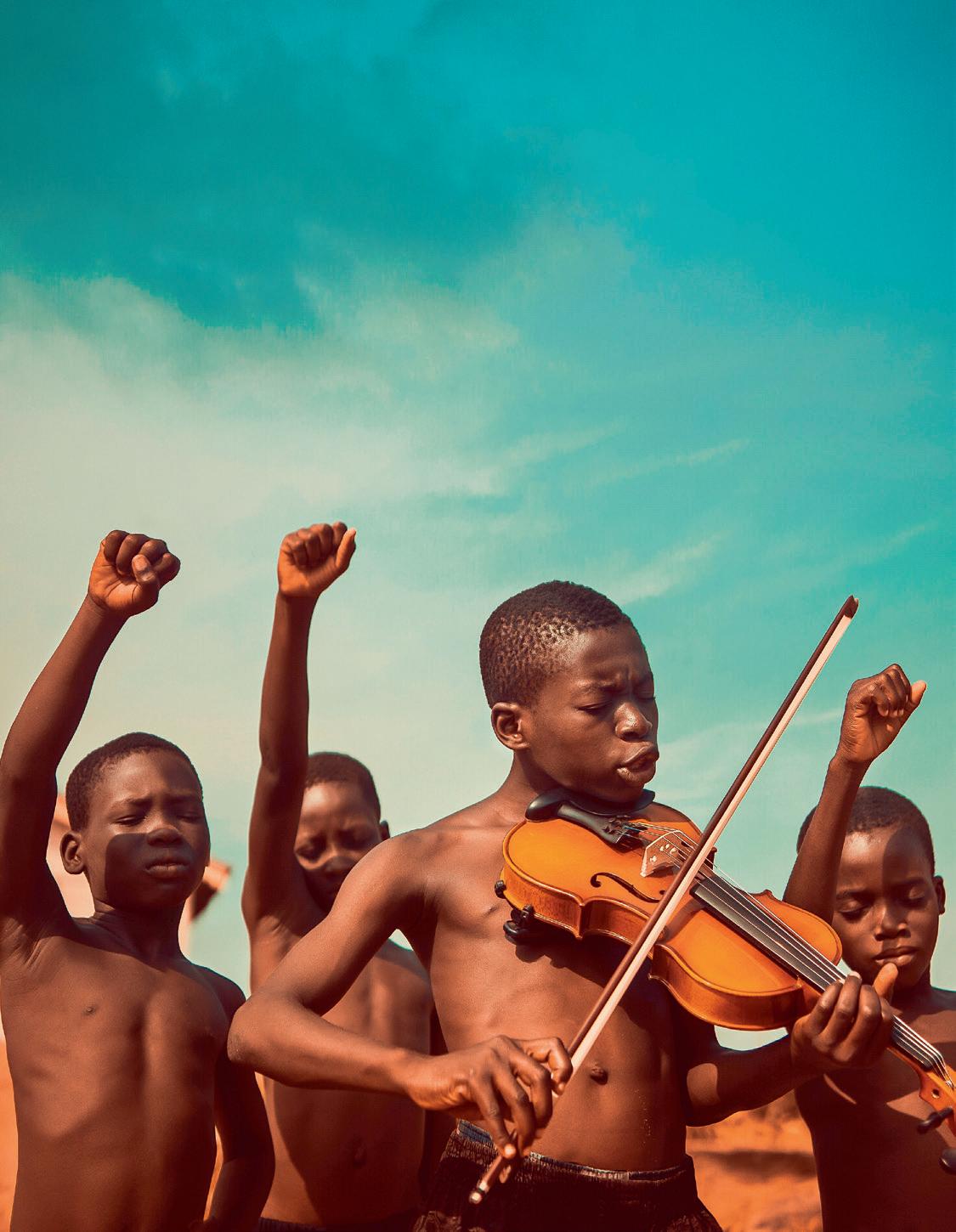
5 minute read
Michael Aboya
Prize winner finds freedom in photography Michael Aboya
All images courtesy of Michael Aboya





Young Ghanaian photographer Michael Aboya is now US$ 25,000 richer after winning Best Photo of the Year in the Agora Awards. Here we reveal how his heartwarming work aims to inspire a change in the way people perceive Ghana and Africa.
Apre-teen African boy stands bare-chested on Labadi Beach, in Accra. He has a violin tucked under his chin and his face appears both focused on and transported by the music he is creating. Behind him stand four similarly topless boys their eyes closed and with their right arms raised in silent salute. All the children are framed by an expanse of turquoise sky that is burnished by the early morning sun.
It’s a wonderfully striking image, at once both powerful and delicate. Caught on camera by 24-year-old self-taught Ghanaian photographer Michael Aboya and called ‘Songs of Freedom’ it was named Best Photo of the Year at the Agora Awards. Aboya was presented with his award along with a life-changing cheque for US$ 25,000 at a ceremony held in Barcelona last November.
Octavi Royo, the chief executive and co-founder of Agora – the freeto-use photography app which received more than 130,000 submissions from its community of professional and amateur photographers across 193 countries for the competition – praised the image as an “intelligent visual manifesto of a current reality and, at the same time, an optimistic and dignified message about the future”.

Inspiration The idea for the picture came to Aboya while he was at home, listening to Bob Marley’s ‘Redemption Song’, which contains the refrain ‘Songs of Freedom’ and talks of slavery, both physical and mental. As soon as the track began playing, Aboya knew he wanted to bring it to life with his camera.
Aboya had been aware of the children in Labadi – all local kids from local fishermen’s families – for some time and has seen them as a source of inspiration, using their beach football games in an earlier photograph, ‘Unity’. In framing ‘A Song of Freedom’, Aboya gathered the children together while a musician friend, who had brought along his violin, taught the children the

basics of handling and playing the instrument. One of the young boys stood out for his expressive way with the bow.
Freedom in photography Aboya takes up the story: “In order to get the image as real and natural as possible without losing the most important aspect of who they really are, I asked my friend to teach them the basics on how to hold the violin, the perfect hand positions and I saw that one of the boys had the strongest expression with the violin, which was perfectly aligned with my vision for the photograph.”
Fitting for an image that melds inspiration from the lyrics of an AfroJamaican stemmed from the Atlantic slave trade and a vision of hope and innocence in the youth of an African homeland, the photograph has had a particularly strong impact among users of the Agora app – who all had a vote in the competition – from the African diaspora. It symbolises more than just a photo to them: the end result visualizes an unspoken struggle for freedom and belonging, conceptualized through the violin, which Aboya describes as an instrument of the soul.
He says: “I created this image to emphasize the fact that we have the power to free ourselves from any
form of mental, physical, spiritual and emotional captivity.”
For Aboya, that freedom was found in photography. “Doing what you love is freedom and loving what you do is freedom,” he says. In 2014, while still a teenager, Aboya lost his father to cancer – a tragedy that made him realise life was too short to spend it doing something he didn’t enjoy. He ditched the course in software programming to pursue his dream of a career in photography.
Self-taught The school fees he saved went on his first professional camera.
“After I purchased my first camera, the next step was to join a photography school, but the fees made that impossible,” he says.
“So I invested a lot of time reading about photography, and watching YouTube videos on how professional photographers shot and used different kinds of lighting to their advantage. I would then go out with my camera to practice by shooting anything I found interesting, and then go home and do some editing. I kept doing this over and over again until I gradually started getting good at it.”
Aboya began to build a portfolio of images, many of which he submitted to the free-to-use Agora app,

portraying a cheerful and optimistic representation of the life around him.
Whether at work or at play, the subjects have gleaming, wide smiles and there are many images celebrating the beauty of strong, stylish black women. Aboya aims to inspire a change in the way people perceive Ghana and the African continent in general.
With his US$ 25,000 prize money, the highest in the contest’s history, Aboya plans to invest in his passion and continue to develop his photography skills
“I’ll be able to get the gear I need”, he says. “I’ll invest into learning videography, putting my visions into moving pictures, visiting new places I have never been to capture the beautiful people and their colourful stories. I’ll support my family and give back to the community of youths.”
To see Aboya’s latest work, visit his Instagram page @aboya.8
To join the Agora community, see the variety of haunting portraits, stunning landscapes and incredible pieces of photojournalism and start posting your own images, download the app at agoraimages.com









